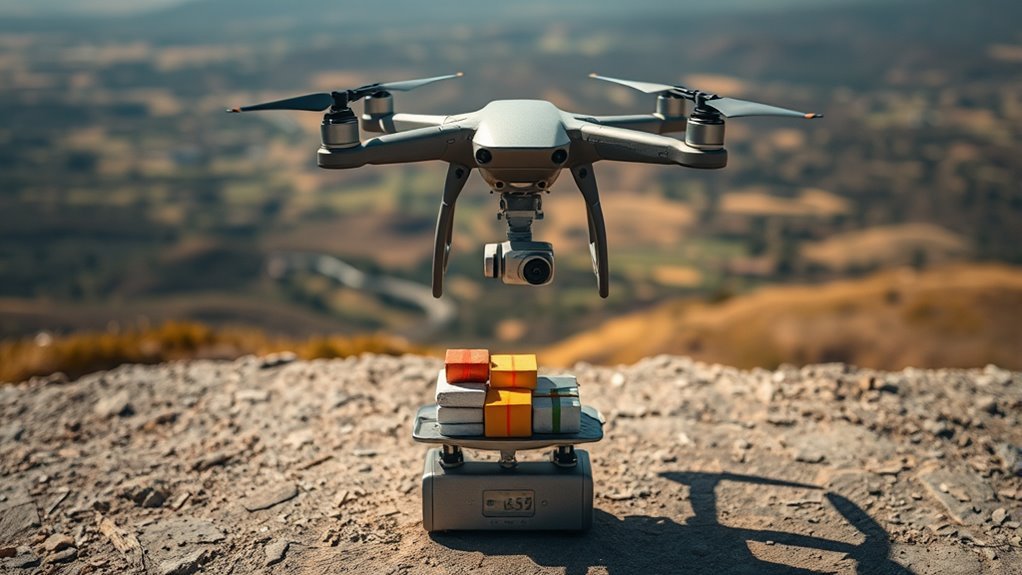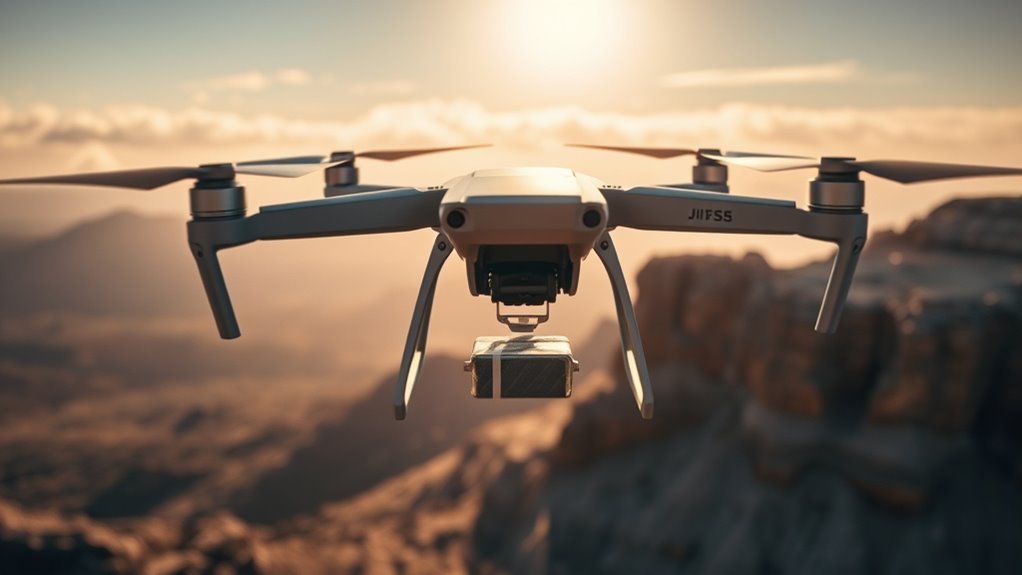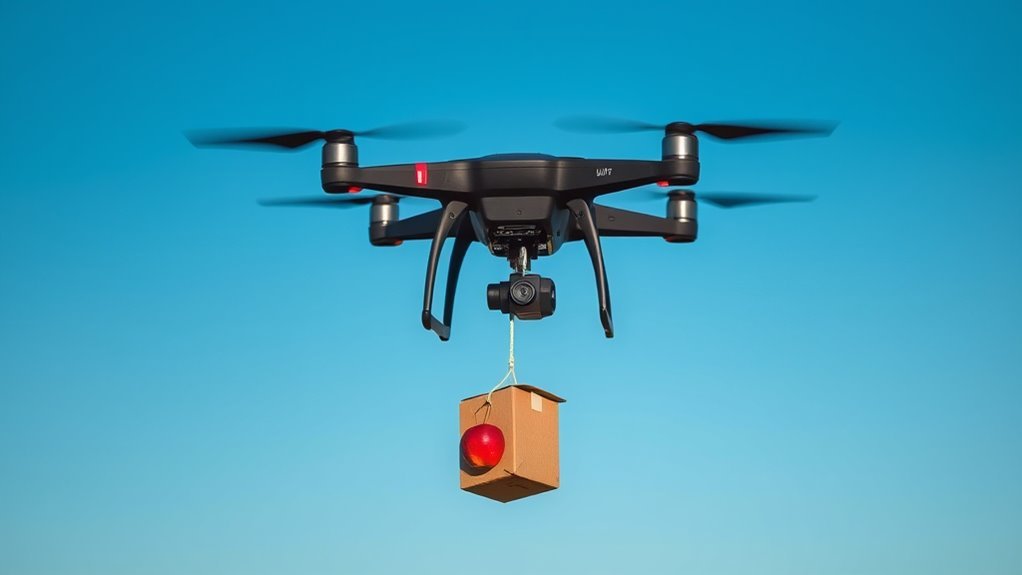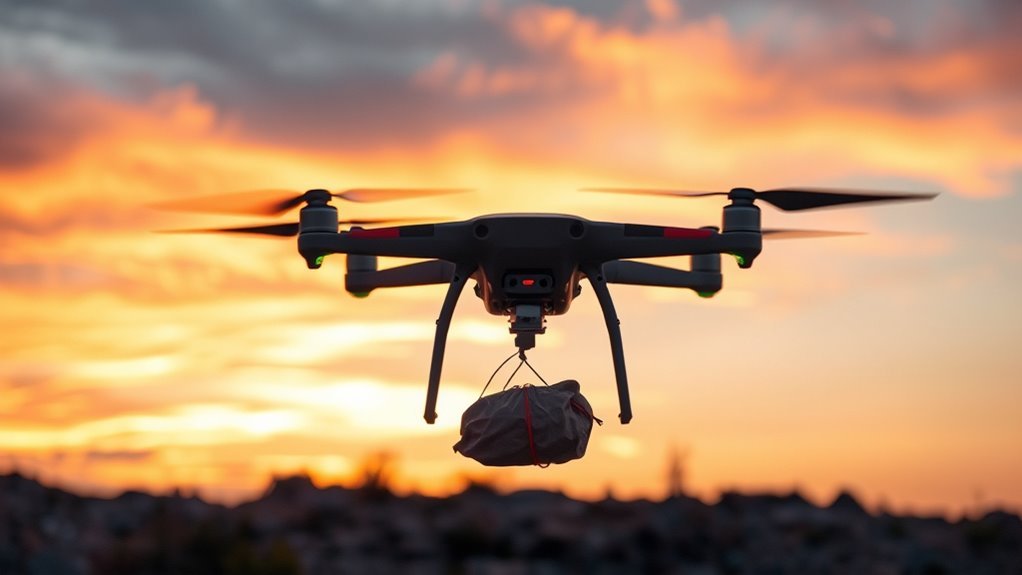You’ll face strict weight limits because extra load strains motors and cuts battery life, limiting flight duration. Payload shape and size affect aerodynamics, reducing stability and control. Environmental factors like wind and temperature further impact performance. Regulatory rules also restrict what and where you can carry. Safety concerns arise from mechanical risks and altered flight dynamics. Understanding these constraints is key if you want to optimize your drone’s carrying capabilities and maximize operational efficiency.
Weight Capacity Constraints

Although drones have advanced considerably, their weight capacity remains a critical limitation you must consider when planning payload transportation. You’ll need to apply payload optimization strategies meticulously to maximize efficiency without exceeding the drone’s structural thresholds. This involves selecting materials with high strength-to-weight ratios, emphasizing material composition considerations that minimize overall mass while maintaining durability. Utilizing lightweight composites or carbon fiber components can enhance payload capacity without compromising stability. You must also analyze aerodynamic impacts caused by added weight, as excess mass can degrade flight performance and control responsiveness. Balancing these factors enables you to push the boundaries of drone freedom, yet you must remain within strict weight limits to avoid compromising safety, flight integrity, or regulatory compliance. Your approach should prioritize precision and disciplined payload management to fully leverage your drone’s operational potential.
Battery Life and Flight Duration

Since battery technology directly influences a drone’s operational window, you need to carefully evaluate energy density and power consumption when considering flight duration. Battery technology advancements have gradually extended flight times, yet current limitations persist. You must factor in:Battery tech shapes drone flight time—energy density and power use are key factors to weigh carefully.
- Energy density: Higher values mean longer operational periods but often at increased weight.
- Power consumption: Efficient motors and electronics minimize energy use, maximizing endurance.
- Weight trade-offs: Larger batteries add mass, reducing payload capacity and agility.
- Environmental conditions: Temperature and wind affect battery performance and drain rates.
Energy efficiency improvements in drone components can extend flight duration, but the balance between battery size and payload remains essential. To truly experience aerial freedom, you’ll need to optimize these variables, understanding that flight duration hinges on a delicate interplay between power supply and consumption.
Impact of Payload on Flight Stability

When you add payload to a drone, its weight distribution shifts, directly affecting flight stability and control responsiveness. Uneven loads can cause imbalances, forcing the drone to compensate continuously and increasing energy consumption. Additionally, the payload alters the drone’s aerodynamics, potentially introducing drag and turbulence that disrupt smooth flight.
Weight Distribution Effects
Even if a drone’s total payload is within its maximum capacity, uneven weight distribution can greatly compromise flight stability. When you load a drone improperly, the imbalance affects its center of gravity, leading to unstable flight behavior. You need to focus on precise weight distribution and effective load balancing to maintain control. Here’s what happens when weight distribution is off:
- Increased power consumption as motors compensate for tilt
- Reduced maneuverability due to asymmetric lift
- Higher risk of drift and unintended yaw or pitch movements
- Accelerated wear on motors working harder on one side
Aerodynamic Challenges
Although drones are engineered for maximum aerodynamic efficiency, adding a payload inevitably alters airflow patterns around the frame and rotors. When you attach cargo, the drag coefficient increases, which means more aerodynamic resistance. This added drag disrupts smooth airflow, forcing the motors to exert extra power to maintain lift generation. Consequently, flight stability suffers, especially during rapid maneuvers or in turbulent conditions. You must recognize that even slight changes in shape or size of the payload can shift the center of pressure, complicating balance and control responsiveness. To preserve freedom in flight, you’ll need to optimize payload design and positioning carefully. Otherwise, your drone’s ability to sustain stable, efficient lift diminishes, limiting operational range and endurance considerably.
Regulatory and Legal Restrictions
Since drones operate within complex airspace environments, regulatory and legal restrictions critically shape their cargo-carrying capabilities. You must navigate stringent regulatory frameworks that limit payload weight, flight paths, and operational altitudes to guarantee safety and compliance. Legal liabilities further constrain what and where you can transport, demanding thorough risk assessments and insurance coverage. Key limitations include:
- Payload weight caps imposed by aviation authorities.
- Restrictions on flying over populated or sensitive areas.
- Mandatory pilot certifications and operational permits.
- Liability concerns tied to potential property damage or injury.
These constraints protect public safety but also restrict your freedom to maximize drone utility. Understanding and adhering to these legal parameters is essential for responsible, lawful cargo drone operations.
Weather and Environmental Limitations
When operating drones for cargo transport, you must account for weather and environmental factors that greatly impact performance and safety. Wind interference poses a significant challenge, as gusts can destabilize flight paths, reduce payload control, and increase energy consumption. Precise wind speed and direction assessments are essential to maintaining stability and avoiding delivery failures. Additionally, environmental hazards such as rain, fog, and extreme temperatures can impair sensors, degrade battery efficiency, and compromise structural integrity. These conditions limit operational windows and require robust drone designs with weather-resistant materials and adaptive flight control systems. By understanding these constraints, you can optimize drone deployment strategies, ensuring reliable cargo delivery while preserving your freedom to operate beyond conventional limits. Ignoring these factors risks mission failure and threatens both the drone and its payload.
Size and Shape of Carried Items
You need to evaluate strict item dimension constraints, as oversized cargo can disrupt a drone’s stability and control. The aerodynamic shape of what you carry directly affects flight efficiency and energy consumption. Additionally, attachment mechanisms impose limits on the size and shape of items you can securely transport.
Item Dimensions Constraints
Although drones have advanced payload capacities, the dimensions of the items they carry impose strict limits on operational feasibility. You’ll need to evaluate how item shape interacts with payload design to maintain stability and control. Oversized or irregularly shaped items can disrupt balance, reducing flight efficiency and safety. Key constraints include:
- Maximum allowable width and length to fit within the drone’s carrying frame.
- Height restrictions preventing interference with rotors or sensors.
- Weight distribution requirements ensuring center of gravity alignment.
- Secure attachment points compatible with the drone’s payload system.
Understanding these dimensional constraints is essential for maximizing your drone’s freedom in transport tasks while preserving flight dynamics and reliability. Neglecting these factors risks compromising mission success and equipment integrity.
Aerodynamic Shape Effects
Since aerodynamic efficiency directly influences drone performance, the size and shape of carried items play a critical role in flight dynamics. You must consider how the aerodynamic design of the payload affects lift generation and drag forces. Bulky or irregularly shaped objects disrupt airflow, increasing drag and reducing the drone’s effective lift-to-weight ratio. This forces the motors to expend more energy, limiting flight time and maneuverability. Conversely, streamlined shapes aligned with the drone’s flight vector minimize turbulence, preserving ideal lift generation. When selecting cargo, you should prioritize items with compact, smooth contours to maintain aerodynamic stability. Ignoring shape effects can result in inefficient energy consumption and unstable flight, restricting your operational range and freedom. Understanding these aerodynamic constraints guarantees you maximize your drone’s carrying potential without compromising control.
Attachment Mechanism Limits
Beyond aerodynamic considerations, the physical interface between the drone and its payload imposes strict size and shape constraints. Your choice of attachment types and release mechanisms directly impacts how well the drone can secure and deploy items. To optimize freedom in what you carry, consider these factors:
- Compatibility of payload shape with standardized attachment points—irregular forms may require custom mounts.
- Maximum dimensions allowed by the release mechanism to guarantee smooth detachment without snagging.
- Weight distribution relative to the attachment to maintain drone stability during flight.
- Limitations imposed by the mechanical design of release mechanisms, which often favor compact, rigid items over flexible or oversized ones.
Understanding these limits lets you push boundaries without compromising safety or functionality.
Technological Challenges in Payload Management
When you consider the intricacies of payload management, it becomes clear that drones face significant technological hurdles in balancing weight, stability, and power consumption. You must optimize payload strategies to maximize efficiency without compromising flight time or maneuverability. Excess weight strains propulsion systems, reducing battery life and limiting operational range. Additionally, integrating payloads alters the drone’s center of gravity, challenging drone navigation systems that rely on precise sensor data for stability. You have to account for dynamic shifts during flight, requiring advanced algorithms to adjust control inputs in real time. Achieving this balance demands cutting-edge materials and software to maintain responsiveness while carrying loads. Without addressing these technological challenges, your drone’s capability to deliver or transport items remains severely restricted.
Safety Concerns and Risk Factors
Although drones have advanced considerably, safety concerns and risk factors remain critical limitations in their payload capabilities. When you’re relying on drones to carry loads, you must navigate stringent safety regulations designed to minimize hazards. Thorough risk assessment is essential before every flight, especially as payload weight and stability directly impact flight control. Key safety issues include:
- Potential for mechanical failure under excessive load
- Increased risk of collision due to altered aerodynamics
- Battery depletion accelerated by heavier payloads
- Legal constraints limiting operational zones and altitudes
Understanding these factors helps you balance your desire for operational freedom with mandatory safety protocols. Without addressing these risks, the promise of drone freight remains constrained, underscoring why payload management must integrate rigorous safety evaluations every step of the way.

